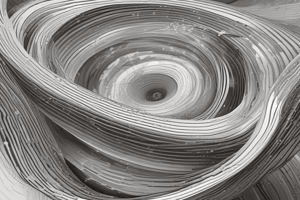Podcast
Questions and Answers
What is the formula for calculating pressure in a fluid?
What is the formula for calculating pressure in a fluid?
- $P = F + A$
- $P = A - F$
- $P = F/A$ (correct)
- $P = A/F$
What defines a substance as a fluid?
What defines a substance as a fluid?
- A substance that does not change volume
- A substance that can flow (correct)
- A substance that changes density rapidly
- A substance that has a fixed shape
Which of the following correctly states the relationship of mass density?
Which of the following correctly states the relationship of mass density?
- It is the volume divided by mass
- It is the mass divided by volume (correct)
- It varies with the object's shape
- It remains constant regardless of particle arrangement
Which unit is used to measure pressure in the International System of Units (SI)?
Which unit is used to measure pressure in the International System of Units (SI)?
Why are gases considered compressible compared to liquids?
Why are gases considered compressible compared to liquids?
What causes pressure in a liquid at rest?
What causes pressure in a liquid at rest?
In hydrostatic equilibrium, how does pressure behave in a connected liquid?
In hydrostatic equilibrium, how does pressure behave in a connected liquid?
What is the unit of mass density in the International System of Units (SI)?
What is the unit of mass density in the International System of Units (SI)?
If a piece of glass is broken into two pieces, how does its mass density change?
If a piece of glass is broken into two pieces, how does its mass density change?
If the pressure at the surface of a body of water changes to $p_0 + Δp$, what happens to the pressure at a depth $d$?
If the pressure at the surface of a body of water changes to $p_0 + Δp$, what happens to the pressure at a depth $d$?
What is the maximum pressure that a human eardrum with an area of 70 mm² can withstand before rupturing?
What is the maximum pressure that a human eardrum with an area of 70 mm² can withstand before rupturing?
Which of the following statements correctly describes fluid pressure?
Which of the following statements correctly describes fluid pressure?
How does pressure in a fluid change with increasing depth?
How does pressure in a fluid change with increasing depth?
Which of the following options best represents what can change for a gas sample?
Which of the following options best represents what can change for a gas sample?
Which of the following statements about hydrostatic pressure is true?
Which of the following statements about hydrostatic pressure is true?
What characterizes solids, liquids and gases in terms of molecular arrangement?
What characterizes solids, liquids and gases in terms of molecular arrangement?
What property of mass density is critical for understanding the differences among solids, liquids, and gases?
What property of mass density is critical for understanding the differences among solids, liquids, and gases?
What occurs to horizontal forces in a fluid at rest?
What occurs to horizontal forces in a fluid at rest?
What happens when a fluid is brought to a different height in a container?
What happens when a fluid is brought to a different height in a container?
How does the mass density of a substance change when its volume increases while its mass remains constant?
How does the mass density of a substance change when its volume increases while its mass remains constant?
Flashcards
Fluid
Fluid
A substance that flows and takes the shape of its container. Examples include liquids and gases.
Density (mass density)
Density (mass density)
The mass of a substance per unit volume.
Mass Density Units
Mass Density Units
Kilograms per cubic meter (kg/m³)
Density Comparison (Solids, Liquids, Gases)
Density Comparison (Solids, Liquids, Gases)
Signup and view all the flashcards
Mass Density Independence
Mass Density Independence
Signup and view all the flashcards
Compressibility of Gases
Compressibility of Gases
Signup and view all the flashcards
Fluid Pressure
Fluid Pressure
Signup and view all the flashcards
Density Characteristic Property
Density Characteristic Property
Signup and view all the flashcards
Pascal's Principle
Pascal's Principle
Signup and view all the flashcards
Phases of matter
Phases of matter
Signup and view all the flashcards
Pascal
Pascal
Signup and view all the flashcards
Hydrostatic Pressure
Hydrostatic Pressure
Signup and view all the flashcards
Hydrostatic Pressure Equation
Hydrostatic Pressure Equation
Signup and view all the flashcards
Connected Liquid Pressure
Connected Liquid Pressure
Signup and view all the flashcards
Pressure Change Effect
Pressure Change Effect
Signup and view all the flashcards
Pressure at Point
Pressure at Point
Signup and view all the flashcards
Pressure Measurement
Pressure Measurement
Signup and view all the flashcards
Eardrum Pressure
Eardrum Pressure
Signup and view all the flashcards
Maximum Dive Depth
Maximum Dive Depth
Signup and view all the flashcards
Study Notes
Fluids Part I
- Fluids are substances that flow, taking the shape of their container.
- Fluids include liquids and gases.
- Gases are compressible, meaning their volume can change easily.
- Liquids are incompressible, their volume remains relatively constant.
- Mass density is the ratio of mass to volume (ρ = m/V).
- SI units of mass density are kg/m³.
- Gases have lower densities compared to liquids and solids due to the greater spacing between gas molecules.
- Pressure in a fluid is the force exerted per unit area (P = F/A).
- The SI unit of pressure is the pascal (Pa), where 1 Pa = 1 N/m².
- The force due to fluid pressure acts on all parts of the fluid and the container walls.
- Pressure in a liquid increases with depth.
- Hydrostatic pressure is the pressure exerted by a fluid at rest.
- Hydrostatic pressure equation is p = p₀ + ρgd
- Pascal's principle states that a pressure change at one point in an incompressible fluid is transmitted equally to all other points in the fluid.
Learning Objectives
- Students will be able to discuss the density of solids, liquids, and gases.
- Students will be able to explain Pascal's principle.
Problem 13.9
- A cylinder contains 25 cm of water and oil on top of the water to a total depth of 40 cm.
- The gauge pressure at the bottom of the cylinder needs to be calculated.
- Density of oil (ρ₀) = 900 kg/m³.
Check Your Understanding
- Q1: Rank the mass densities of three pieces of glass (1, 2, 3) broken from a larger piece in order from largest to smallest.
- Mass density is independent of size, and characteristic of the substance.
- Q2: Gases are compressible.
- The volume of a gas is easily changed.
- Q3: Rank pressures A, B, C, D, E, and F from largest to smallest. (Diagram required)
- Q4: Maximum depth a person could dive without rupturing their eardrum.
- Human eardrum area ≈ 70 mm²
- Maximum force the eardrum can withstand ≈ 7 N Density of water (ρwater) = 1000 kg/m³
Additional Information
- Chapter 13 Questions: 1, 2, 4, 13, 34 (Page 459)
- Chapter 13 Problems: 1, 11, 14, 44 (Page 461)
Studying That Suits You
Use AI to generate personalized quizzes and flashcards to suit your learning preferences.




